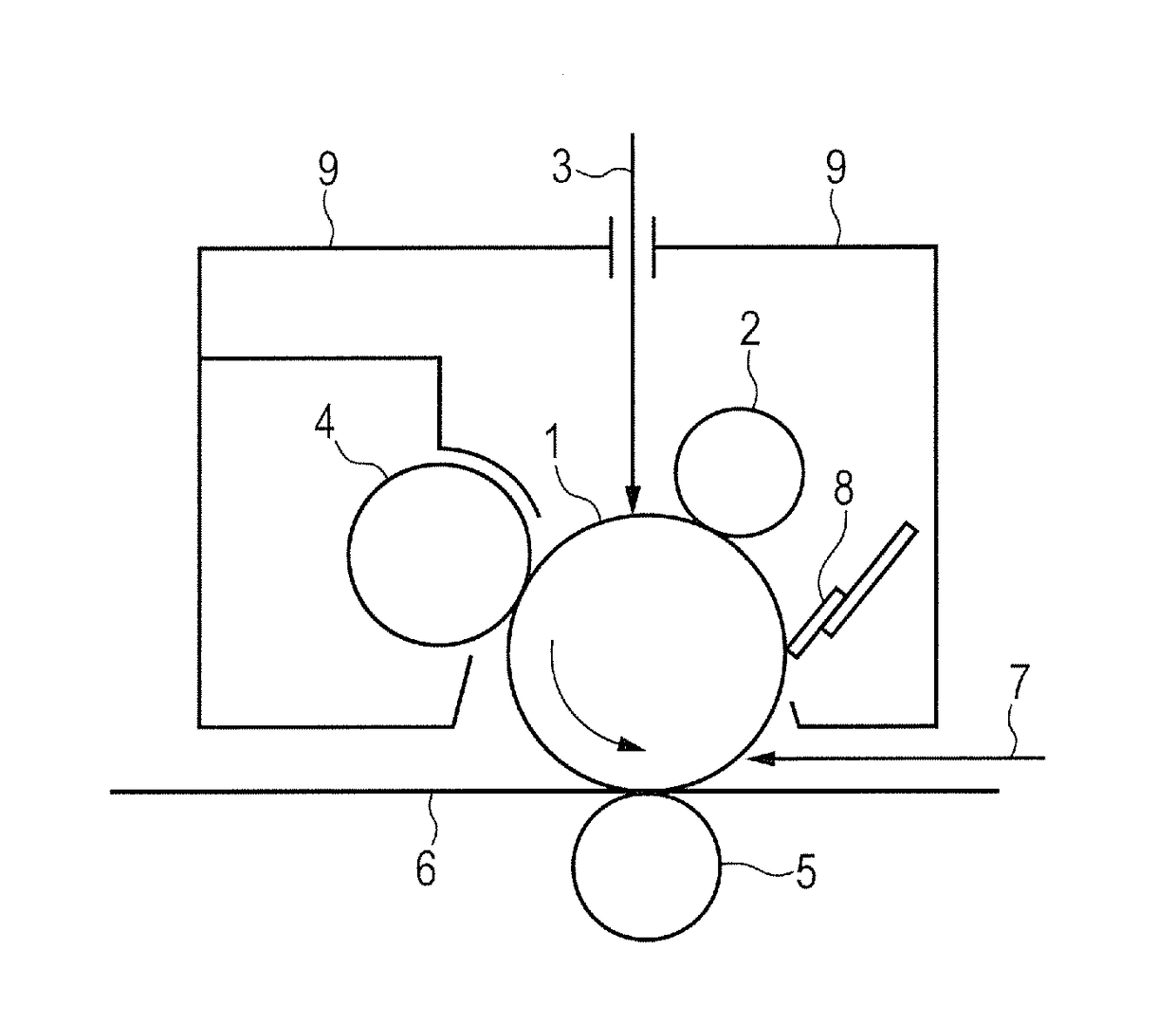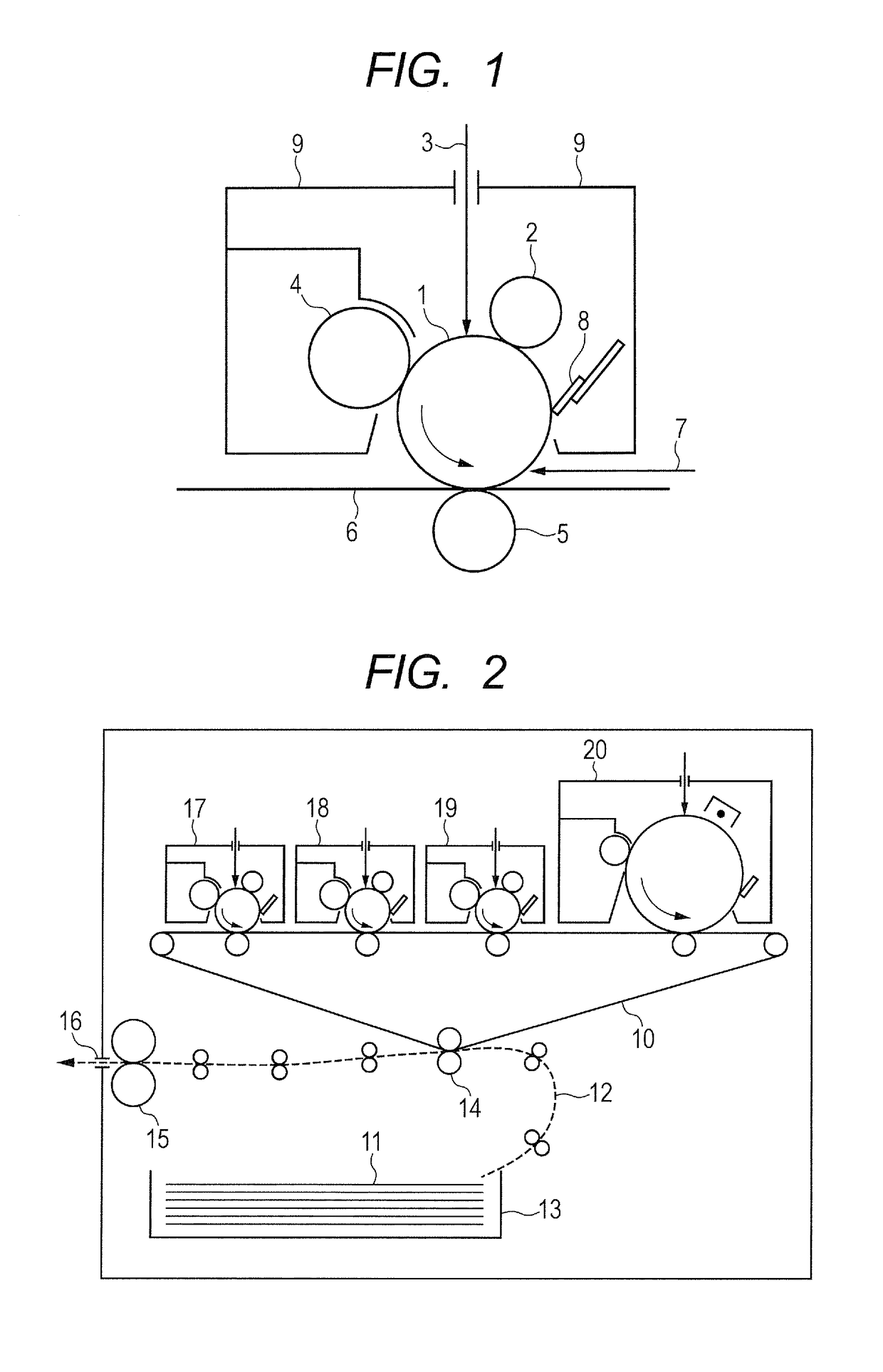Electrophotographic photosensitive member, process cartridge, and electrophotographic apparatus
a photosensitive member and electrophotography technology, applied in electrography/magnetography, optics, instruments, etc., can solve the problems of affecting the photosensitivity of the photosensitive member, the surface of the surface layer is hardly refreshed, and the chemical stability of the hole transportable compound itself is liable to increase, so as to suppress image defects and improve the chemical stability. , the effect of good electrical characteristics
- Summary
- Abstract
- Description
- Claims
- Application Information
AI Technical Summary
Benefits of technology
Problems solved by technology
Method used
Image
Examples
example 1
[0155]A cylindrical aluminum cylinder having an outer diameter of 30.0 mm, a length of 357.5 mm, and a wall thickness of 0.7 mm was used as a support (conductive support).
[0156]Next, 10 parts of zinc oxide particles (specific surface area: 19 m2 / g, powder resistivity: 4.7×106 Ω·cm) were mixed with 50 parts of toluene by stirring, and 0.08 part of a silane coupling agent was added to the mixture, followed by stirring for 6 hours. After that, toluene was removed by distillation under reduced pressure and the residue was dried by heating at 130° C. for 6 hours to provide surface-treated zinc oxide particles. KBM602 (compound name: N-2-(aminoethyl)-3-aminopropylmethyldimethoxysilane) manufactured by Shin-Etsu Chemical Co., Ltd. was used as the silane coupling agent.
[0157]Next, 15 parts of a polyvinyl butyral resin (weight-average molecular weight: 40,000, trade name: BM-1, manufactured by Sekisui Chemical Co., Ltd.) and 15 parts of a blocked isocyanate (trade name: Sumidur 3175, manufac...
example 2
[0171]An electrophotographic photosensitive member (Example Photosensitive Member 2) was produced in the same manner as in Example 1 except that in Example 1, a protective layer was formed as described below.
[0172]A protective layer coating liquid was prepared by dissolving 4 parts of Exemplified Compound No. 24 in 100 parts of ethylene glycol dimethyl ether.
[0173]The protective layer coating liquid was applied onto the hole transporting layer with a spray. The resultant coat was dried for 10 minutes at 50° C., and was subjected to a polymerization curing treatment based on electron beam irradiation and heating under the same conditions as those of Example 1. Next, the aluminum cylinder having formed thereon the coat was taken out to the air atmosphere, and was further heated for 10 minutes at 100° C. Thus, a protective layer having a thickness of 2.5 μm was formed.
[0174]Thus, Example Photosensitive Member 2 was produced.
[0175]The ionization potential of the protective layer was mea...
example 3
[0176]An electrophotographic photosensitive member (Example Photosensitive Member 3) was produced in the same manner as in Example 1 except that in Example 1, a protective layer was formed as described below.
[0177]A protective layer coating liquid was prepared by dissolving 3 parts of Exemplified Compound No. 26 and 1 part of 1,10-bis(acryloyloxy)decane in 100 parts of ethylene glycol dimethyl ether.
[0178]The protective layer coating liquid was applied onto the hole transporting layer with a spray in the same manner as in Example 2, and the resultant coat was dried and cured to form a protective layer.
[0179]Thus, Example Photosensitive Member 3 was produced.
[0180]The ionization potential of the protective layer was measured by the same method as that of Example 1. The ionization potential of the protective layer of Example Photosensitive Member 3 was 5.8 eV.
PUM
 Login to View More
Login to View More Abstract
Description
Claims
Application Information
 Login to View More
Login to View More - R&D
- Intellectual Property
- Life Sciences
- Materials
- Tech Scout
- Unparalleled Data Quality
- Higher Quality Content
- 60% Fewer Hallucinations
Browse by: Latest US Patents, China's latest patents, Technical Efficacy Thesaurus, Application Domain, Technology Topic, Popular Technical Reports.
© 2025 PatSnap. All rights reserved.Legal|Privacy policy|Modern Slavery Act Transparency Statement|Sitemap|About US| Contact US: help@patsnap.com



